Multiple choice question for engineering
Set 1
1. __________is a workable paste used to bind building blocks such as stones, bricks, and concrete masonry units.
a) Lime
b) Cement
c) Mortar
d) Concrete
Answer
Answer: c [Reason:] Mortar is a workable paste used to bind building blocks such as stones, bricks, and concrete masonry units together, fill and seal the irregular gaps between them, and sometimes add decorative colours or patterns in masonry walls. In its broadest sense mortar includes pitch, asphalt, and soft mud or clay, such as used between mud bricks. Mortar comes from Latin mortarium meaning crushed.
2. __________is a liquid or semi-liquid mixture of water and any combination of different kinds of soil (loam, silt, and clay).
a) Mud
b) Concrete
c) Mortar
d) Paint
Answer
Answer: a [Reason:] Mud is a liquid or semi-liquid mixture of water and any combination of different kinds of soil (loam, silt, and clay). It usually forms after rainfall or near water sources. Ancient mud deposits harden over geological time to form sedimentary rock such as shale or mudstone (generally called lutites). When geological deposits of mud are formed in estuaries the resultant layers are termed bay muds.
3. __________ is composed of lime and an aggregate such as sand, mixed with water.
a) Lime mortar
b) Concrete
c) Cement
d) Gypsum
Answer
Answer: a [Reason:] Lime mortar today is primarily used in the conservation of buildings originally built using lime mortar, but may be used as an alternative to ordinary portland cement. It is made principally of lime (hydraulic, or non hydraulic), water and an aggregate such as sand.
The below diagram is for question number 4 and 5.
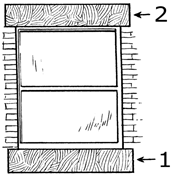
4. What does ‘2’ denotes in the above window diagram?
a) Lintel
b) Sill
c) Header
d) Terrace
Answer
Answer: a [Reason:] A lintel or lintol is a structural horizontal block that spans the space or opening between two vertical supports. It can be a decorative architectural element, or a combined ornamented structural item. It is often found over portals, doors, windows and fireplaces. Modern day lintels are made using prestressed concrete and are also referred to as beam in beam and block slabs or ribs in rib and block slabs. These prestressed concrete lintels and blocks are components that are packed together and propped to form a suspended floor concrete slab.
5. What does ‘1’ denotes in the above window diagram?
a) Chowkhat
b) Sill
c) Base
d) Shelve
Answer
Answer: b [Reason:] A window cill (also written as windowsill or window-sill) is the surface at the bottom of a window. A dictionary of architecture categorically defined the characteristics of a windowsill as: The lowest form of window casement. Windowsills hold pieces in place and slope downward to drain water.
6._____________covers the entire wall with thin liquid plaster, uses a great deal of water and is applied very wet.
a) Lime plastering
b) Heat resistant plastering
c) Veneer plastering
d) Gypsum plastering
Answer
Answer: c [Reason:] Veneer plastering covers the entire wall with thin liquid plaster, uses a great deal of water and is applied very wet. The walls intended to be plastered are hanged with “Blueboard” (named as such for the industry standard of the outer paper being blue-grey in color). This type of sheet rock is designed to absorb some of the moisture of the plaster and thus allow it to cling the plaster better before it sets.
Veneer plastering is a one-shot one-coat application; taping usually requires sanding and then adding another coat, since the compound shrinks as it dries.
7. The most common type of ceiling is the___________which is suspended from structural elements above.
a) parabolic ceiling
b) curved ceiling
c) dropped ceiling
d) arched ceiling
Answer
Answer: c [Reason:] The most common ceiling that contributes to fire-resistance ratings in commercial and residential construction is the dropped ceiling. In the case of a dropped ceiling, the rating is achieved by the entire system, which is both the structure above, from which the ceilings is suspended, which could be a concrete floor or a timber floor, as well as the suspension mechanism and, finally the lowest membrane or dropped ceiling. Between the structure that the dropped ceiling is suspended from and the dropped membrane, such as a T-bar ceiling or a layer of drywall, there is often some room for mechanical and electrical piping, wiring and ducting to run.
8. The term ___________in construction is applied to the finishing of mortar joints in masonry (stone or brick). In exposed masonry, these are considered to be the weakest part.
a) painting
b) deteriorating
c) pointing
d) finishing
Answer
Answer: c [Reason:] The term Pointing in construction is applied to the finishing of mortar joints in masonry (stone or brick). In exposed masonry, joints are considered to be the weakest and most vulnerable spots from which rain water or dampness can enter. Pointing means implementing the joints to a depth of 10 to 20mm and filling it with better quality mortar in desired shape.
Set 2
1. ___________ are combination of more than two straight or curved scales aligned in a definite way so that when a straight line drawn across the scales intersects them at values satisfying the represented equation.
a) Hydrograph
b) Namographs
c) Nomographs
d) Hygrograph
Answer
Answer: c [Reason:] A nomogram (from Greek νόμος nomos, “law” and γραμμή grammē, “line”), also called a nomograph, alignment chart or abaque, is a graphical calculating device, a two-dimensional diagram designed to allow the approximate graphical computation of a mathematical function. An arrangement of two linear or logarithmic scales such that an intersecting straight line enables an intermediate values or values on a third scale to be read off.
2. Which is not the type of nomograph?
a) Z- type nomograph
b) Circular nomograph
c) Y- type nomograph
d) Combination of nomograph
Answer
Answer: c [Reason:] Y- type nomograph does not exist. The other fourth type of nomographs includes Parallel scales nomograph.
3. Which short of instrument is shown below?
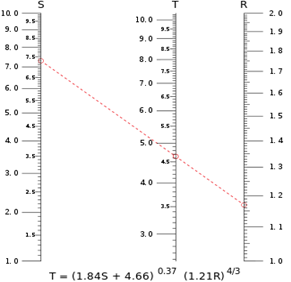
a) 3 Geometrical scale
b) Parallel-scale nomogram
c) Thermometer
d) Barometer
Answer
Answer: b [Reason:] The field of nomography was invented in 1884 by the French engineer Philbert Maurice d’Ocagne (1862-1938) and used extensively for many years to provide engineers with fast graphical calculations of complicated formulas to a practical precision. Nomograms use a parallel coordinate system invented by d’Ocagne rather than standard Cartesian coordinates.
A nomogram consists of a set of n scales, one for each variable in an equation. Knowing the values of n-1 variables, the value of the unknown variable can be found, or by fixing the values of some variables, the relationship between the unfixed ones can be studied. The result is obtained by laying a straightedge across the known values on the scales and reading the unknown value from where it crosses the scale for that variable. The virtual or drawn line created by the straightedge is called an index line or isopleth.
4. Which is not the application of nomography?
a) Ballistics calculations prior to fire control systems, where calculating time was critical.
b) Operations Research, to obtain results in a variety of optimization problems.
c) The design of channels, pipes and weirs for regulating the flow of water.
d) In measuring water velocity
Answer
Answer: d [Reason:] The current velocity meter allows you to measure stream flow velocity in feet or meters per second and measure water depth in hundredths of a foot up to three feet. The average stream flow velocity times the cross-sectional area of the stream determines the stream flow measurement in cubic feet or meters per second.
5. A ___________ is any quantity that always has the same value.
a) Variable
b) Constant
c) Function
d) Stable
Answer
Answer: b [Reason:] A fixed value.
In Algebra, a constant is a number on its own, or sometimes a letter such as a, b or c to stand for a fixed number.
Example: in “x + 5 = 9”, 5 and 9 are constants
If it is not a constant it is called a variable.
6. This is a mathematical equation which expresses the relationship of a group of variables and constants.
a) Function
b) Functional modulus
c) Variables
d) Scales
Answer
Answer: a [Reason:] In mathematics, a function is a relation between a set of inputs and a set of permissible outputs with the property that each input is related to exactly one output. An example is the function that relates each real number x to its square x2. The output of a function f corresponding to an input x is denoted by f(x) (read “f of x”). In this example, if the input is −3, then the output is 9, and we may write f(−3) = 9. Likewise, if the input is 3, then the output is also 9, and we may write f(3) = 9. (The same output may be produced by more than one input, but each input gives only one output.) The input variable(s) are sometimes referred to as the argument(s) of the function.
7. This is defined as the product of functional modulus and common constant coefficient of a function variable.
a) Modulus of elasticity
b) Function
c) Scale modulus
d) Functional modulus
Answer
Answer: c [Reason:] Scale modulus M = Constant coefficient of function * Functional modulus
Z = 2x + 2y = 2 ( x+y )
M= 2* m.
8. This is defined as the length of the scale for a unit value of the functional variable.
a) Functional modulus
b) Young’s modulus
c) Modulus of elasticity
d) Constant modulus
Answer
Answer: a [Reason:] Mathematically, we can write as
m= L/(f(xmax)-f(xmin), where m is the functional modulus
L= scale length
xmax and xmin represent the value of the variable x corresponding to the maximum and minimum values of the function respectively.
Set 3
1. When the receding lines are true length, and the projectors are at 45 degrees to the plane of projection, the oblique drawing is called ______________
a) oblique projection
b) isometric projection
c) axonometric projection
d) cavalier projection
Answer
Answer: d [Reason:] Cavalier projection is a form of oblique projection in which the projection lines are presumed to make a 45-degree vertical and a 45-degree horizontal angle with the plane of projection. Assume that in figure below the line XX’ represents a side-edge view of the plane of projection, and that the square ABCD represents a side of a cube, placed with its front face parallel to, and its top face perpendicular to, the plane of projection. You can see that the projected lengths of AB and AD are the same as the actual lengths.
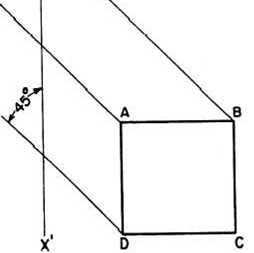
2. In oblique projections, the projectors are perpendicular to each other but are not parallel to the plane of projection.
a)True
b)False
Answer
Answer: b [Reason:] Oblique projection is a type of parallel projection:
• it projects an image by intersecting parallel rays (projectors)
• from the three-dimensional source object with the drawing surface (projection plane).
In both oblique projection and orthographic projection, parallel lines of the source object produce parallel lines in the projected image. The projectors in oblique projection intersect the projection plane at an oblique angle to produce the projected image, as opposed to the perpendicular angle used in orthographic projection.
3. In general, all types of sections for isometric drawing may be applied to oblique drawing.
a) True
b) False
Answer
Answer: b [Reason:] An isometric projection is a technical way of representing an object in three dimensions and may include several oblique views of the object. It’s used extensively in engineering and manufacturing to provide an accurate and detailed view of how an object is designed or put together, whereas an oblique view will always show the object as being perfectly flat with respect to the picture plane (I.e., that particular face of the object will have only two dimensions from the viewer’s point of view).
4. In oblique projections, one of the object’s principal faces is parallel to the plane of projection.
a) True
b) False
Answer
Answer: a [Reason:] In both oblique projection and orthographic projection, parallel lines of the source object produce parallel lines in the projected image. The projectors in oblique projection intersect the projection plane at an oblique angle to produce the projected image, as opposed to the perpendicular angle used in orthographic projection.
5. Oblique sections are useful to show the _____________
a) interior shapes
b) oblique lines
c) foreshortened features
d) projected features
Answer
Answer: a [Reason:] Oblique drawing is also the crudest “3D” drawing method but the easiest to master. One way to draw using an oblique view is to draw the side of the object you are looking at in two dimensions, i.e. flat, and then draw the other sides at an angle of 45°, but instead of drawing the sides full size they are only drawn with half the depth creating ‘forced depth’ – adding an element of realism to the object. Even with this ‘forced depth’, oblique drawings look very unconvincing to the eye. For this reason oblique is rarely used by professional designers and engineers.
6. The term __________ stems from its use in illustrations by the furniture industry.
a) cavalier projection
b) axonometric projection
c) cabinet projection
d) dimetric projection
Answer
Answer: c [Reason:] The term cabinet projection (sometimes cabinet perspective) stems from its use in illustrations by the furniture industry. Like cavalier perspective, one face of the projected object is parallel to the viewing plane, and the third axis is projected as going off in an angle (typically 30° or 45° or arctan (2) = 63.4°). Unlike cavalier projection, where the third axis keeps its length, with cabinet projection the length of the receding lines is cut in half.
7. In _________a point of the object is represented by three coordinates, x, y and z.
a) axonometric projection
b) cavalier projection
c) cabinet projection
d) military projection
Answer
Answer: b [Reason:] In cavalier projection (sometimes cavalier perspective or high view point) a point of the object is represented by three coordinates, x, y and z. On the drawing, it is represented by only two coordinates, x″ and y″. On the flat drawing, two axes, x and z on the figure, are perpendicular and the length on these axes are drawn with a 1:1 scale; it is thus similar to the dimetric projections, although it is not an axonometric projection, as the third axis, here y, is drawn in diagonal, making an arbitrary angle with the x″ axis, usually 30 or 45°. The length of the third axis is not scaled.
8. A variant of ___________is called military projection.
a) 3- projection
b) Orthographic projection
c) Isometric projection
d) Oblique projection
Answer
Answer: d [Reason:] A variant of oblique projection is called military projection. In this case the horizontal sections are isometrically drawn so that the floor plans are not distorted and the verticals are drawn at an angle. The military projection is given by rotation in the xy-plane and a vertical translation an amount z.
9. This figure below is a_____________ in oblique projection.
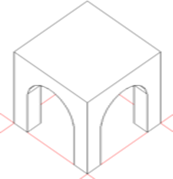
a) Military projection
b) 3- point projection
c) Isometric projection
d) Army projection
Answer
Answer: a [Reason:] A variant of oblique projection is called military projection. In this case the horizontal sections are isometrically drawn so that the floor plans are not distorted and the verticals are drawn at an angle. The military projection is given by rotation in the xy-plane and a vertical translation an amount z.
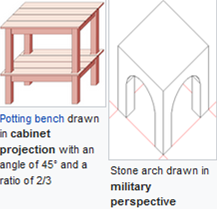
10. The figure below represents_____________ point perspective.
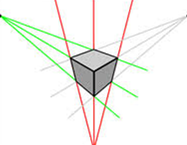
a) 2
b) 3
c) 4
d) 5
Answer
Answer: b [Reason:] The biggest difference in three-point perspective is that there are three vanishing points (VPs). Two are along the horizon, just like two-point, but the third VP is located either above the horizon (at the zenith) or below the horizon (the nadir), depending on the area you intend to draw.
Set 4
1. A______________ may be included in an estimate to provide for unknown costs which are indicated as likely to occur by experience, but are not identifiable.
a) approximate
b) improbability
c) contingency
d) certainty
Answer
Answer: c [Reason:] When using an estimate which has no contingency to set a budget or to set aside funding, a contingency is often added to improve the probability that the budget or funding will be adequate to complete the project. Being unable to complete a project risks public ridicule. See cost contingency for more information. The estimate or budget contingency is not intended to compensate for poor estimate quality, and is not intended to fund design growth, owner changes, or anything else unrelated to delivering the scope as defined in the estimate documentation. Generally more contingency is needed for earlier estimates due to the higher uncertainty of estimate accuracy.
2. Generally for any construction project, three parties are involved namely owner, design professionals and construction professionals.
a) True
b) False
Answer
Answer: a [Reason:] In some cases the design professional and construction professional are from the same company or they form a team through a joint venture for providing service to the owner in the project. It is the responsibility of each party involved in the project to estimate the costs during various stages of the project. An early estimate helps the owner to decide whether the project is affordable within the available budget, while satisfying the project’s objectives.
3. The total project cost consists of two components namely front cost and indirect cost.
a) True
b) False
Answer
Answer: b [Reason:] The total project cost consists of two components namely direct cost and indirect cost. Direct cost includes cost of materials, equipment and labour associated with each item of work and also includes cost of subcontracted works. Indirect costs are the costs which are not associated with each item of work rather these costs are calculated for the entire construction work and includes overhead costs (both job office or site office overhead and general head office overhead), contingency i.e. cost for any unforeseen work and profit.
3. For cost estimating, _________serves as an important framework for organized collection project cost data and preparing the cost estimates at different levels.
a) WCS
b) WPS
c) WMS
d) WBS
Answer
Answer: d [Reason:] For cost estimating, work breakdown structure (WBS) serves as an important framework for organized collection project cost data and preparing the cost estimates at different levels. It is a technique that involves the hierarchical breakdown of the project into different work elements at successive levels and defines the interrelationships between them.
4. The estimate which prepared using any rough method to get the approximate cost construction anticipated in a project is called an ______________estimate.
a) approximate
b) precise
c) exact
d) rough
Answer
Answer: a [Reason:] The approximate estimate is done in order to find out an approximate cost in very short time before starting the project. The estimation is made before selecting the final specification and design of the project. This method is also known as preliminary or rough estimate.
5. Which method is not adopted for volume calculating?
a) From cross-section
b) From spot level
c) From contour
d) From plan
Answer
Answer: d [Reason:] Volume can be measured by a contour map, but the volume calculated by this method is approximate. It cannot be compared with the volume calculated by the cross-section method. As the full ground irregularities are not predicted by contours, and also as the contour intervals are not small, volume calculated from contours is likely to be an approximate one. To calculate volume by this method, general recommendations of contour interval is a maximum of 2 meters for a regular ground surface, and 0.5 meter for an irregular topography.
6. The measurement is not made in square metres in case of ____________
a) D.P.C. (Damp proof course)
b) Form works
c) R.C. chhajjas
d) Concrete Jaffries
Answer
Answer: c [Reason:] A chhajja is the projecting or overhanging eaves or cover of a roof, usually supported on large carved brackets.It forms part of the architecture of Rajasthan, Gujarat, Punjab and Uttar Pradesh. In Rajasthan they are particularly large.
7. Which option is not considered as the duty of quantity surveyor?
a) Preparing bill of quantities (Taking off, squaring, Abstracting and billing), taking little amount for personal use as being quantity surveyor.
b) Preparing bills for part payments at intervals during the execution of work
c) Preparing bill of adjustment in the case of variations ordered during the execution of work
d) Giving legal advice in case of court proceedings
Answer
Answer: a [Reason:] Quantity surveyor duties typically include: Conducting feasibility studies to estimate materials, time and labour costs. Preparing, negotiating and analysing costs for tenders and contracts. Advising on a range of legal and contractual issues. No amount can be kept by anyone without any prior permission of the concerned authority.
8. Which is not the essential quality of a good surveyor?
a) The quality surveyor must be well versed with the drawings of work
b) He should be able to read the drawing correctly and bill the quantities accurately
c) He should have a through knowledge of the construction procedure to be adopted, the various items of works involved in the execution: and the different materials to be used in the work
d) Oral representation of schedule to be priced by tenderor
Answer
Answer: d [Reason:] He should be able to prepare written schedule to be priced by tenderor for better understanding, for future proof, easy in showing the work to multiple people etc.
Set 5
1. The building orientation determines the amount of radiation it receives.
a) True
b) False
Answer
Answer: a [Reason:] Building orientation refers to the way a building is situated on a site and the positioning of windows, rooflines, and other features.
2. In the equatorial location, if solar heat gain is to be avoided, the main windows should face East or West.
a) True
b) False
Answer
Answer: b [Reason:] In the equatorial location, if solar heat gain is to be avoided, the main windows should face north or south. At the higher latitude, an orientation away from the Equator would receive the least sunshine, but here it may be desirable to have some solar heat gain in winter, when the sun is low- so an orientation towards the Equator may be preferable.
3. It is also advised to place unconditioned spaces (garages, closets and other buffer places) in the east and west sides.
a) True
b) False
Answer
Answer: a [Reason:] Orientation for taking advantage of breezes in warm and humid climate and for prevention of hot winds in hot and dry climates is important but not as critical as orientation for solar heat control.
4. In winter, much more radiation falls on the horizontal surface than on the north face.
a) True
b) False
Answer
Answer: b [Reason:] This is because the sun is much higher in the sky, so that the angle of incidence favours the horizontal surface.
5. Daylighting is the practice of placing windows, other openings, and reflective surfaces so that sunlight (direct or indirect) can provide effective internal lighting.
a) True
b) False
Answer
Answer: a [Reason:] Energy savings can be achieved from the reduced use of artificial (electric) lighting or from passive solar heating. Artificial lighting energy use can be reduced by simply installing fewer electric lights where daylight is present or by automatically dimming/switching off electric lights in response to the presence of daylight – a process known as daylight harvesting.
6. During the winter, ACH may range from 0.50 to 0.41 in a tightly air-sealed house to 1.11 to 1.47 in a loosely air-sealed house.
a) True
b) False
Answer
Answer: a [Reason:] For residential buildings, which mostly rely on infiltration for meeting their ventilation needs, a common ventilation rate measure is the air change rate (or air changes per hour): the hourly ventilation rate divided by the volume of the space (I or ACH; units of 1/h).
ASHRAE now recommends ventilation rates dependent upon floor area, as a revision to the 62-2001 standard, in which the minimum ACH was 0.35, but no less than 15 CFM/person (7.1 L/s/person). As of 2003, the standard has been changed to 3 CFM/100 sq. ft. (15 l/s/100 sq. m.) plus 7.5 CFM/person (3.5 L/s/person).
7. Orientations of up to 60° west of north and 45° east of north still allow good passive sun control.
a) True
b) False
Answer
Answer: b [Reason:] Precise orientation is not as critical as many people think. While ideal orientation (in most climates) is solar north, orientations of up to 20° west of north and 30° east of north still allow good passive sun control. As can be seen from the diagram below, good solar orientation is possible on most sites.
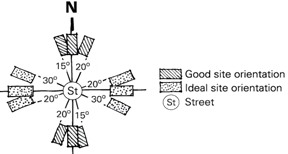
8. The ideal orientation for living areas is within the range 15°W–20°E of true or ‘solar’ north.
a) True
b) False
Answer
Answer: a [Reason:] It allows standard eaves overhangs to admit winter sun to heat the building and exclude summer sun with no effort from the occupants and no additional cost.
Poor orientation can exclude winter sun as well as cause overheating in summer by allowing low angle east or west sun to strike glass surfaces, creating a greenhouse effect where it’s not required. Choose a house that has good orientation or can be easily adapted for better orientation.
9. You can achieve good passive solar performance at minimal cost if you have a right ____________
a) Area
b) Location
c) Space
d) Site
Answer
Answer: d [Reason:] Where possible, choose a site that can accommodate north-facing daytime living areas that flow to outdoor spaces with similar orientation. In tropical areas, northerly solar access is not desirable: sites that allow maximum exposure to cooling breezes and designs that draw or funnel them through the building are preferable.
10. _________roofs have vertical roof glass facing away from the equator side of the building to capture diffused light (not harsh direct equator-side solar gain).
a) Clerestory
b) Sawtooth
c) Translucent
d) Curved
Answer
Answer: b [Reason:] The angled portion of the glass-support structure is opaque and well insulated with a cool roof and radiant barrier. The sawtooth roof’s lighting concept partially reduces the summer “solar furnace” skylight problem, but still allows warm interior air to rise and touch the exterior roof glass in the cold winter, with significant undesirable heat transfer.
11. __________ is a large open space located within a building. It is often used to light a central circulation or public area by daylight admitted through a glass roof or wall.
a) Atrium
b) Solarium
c) Translucent walls
d) Skylights
Answer
Answer: a [Reason:] Atria provide some daylight to adjacent working areas, but the amount is often small and does not penetrate very far. The main function of an atrium is to provide a visual experience and a degree of contact with the outside for people in the working areas. The daylighting of successive storeys of rooms adjoining an atrium is interdependent and requires a balanced approach.
12. A tube structure which is placed into a roof and admits light to a focused area of the interior is _________
a) Solar panel
b) Tubular daylighting device
c) Heliostats
d) Solarium
Answer
Answer: b [Reason:] TDDs use modern technology to transmit visible light through opaque walls and roofs. The tube itself is a passive component consisting of either a simple reflective interior coating or a light conducting fiber optic bundle. It is frequently capped with a transparent, roof-mounted dome “light collector” and terminated with a diffuser assembly that admits the daylight into interior spaces and distributes the available light energy evenly (or else efficiently if the use of the lit space is reasonably fixed, and the user desired one or more “bright-spots”).
Total Views: 13
